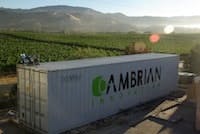Addressing the serious wastewater treatment issues in the food and beverage industry, Cambrian Innovation Inc. announced the commercial availability of EcoVolt. An industrial-scale bioelectrically enhanced system, EcoVolt helps food and beverage companies—including wineries, breweries and dairy operations—cut operating costs and monetize their process and wastewater streams while increasing plant sustainability.
EcoVolt leverages electrically active microbes to stabilize the wastewater treatment process while generating clean energy. This energy can save money, decrease grid reliance and form a core part of a sustainable water management and reuse plan.
“EcoVolt has the potential to revolutionize how wineries and breweries manage water,” said Matthew Silver, CEO of Cambrian Innovation. “Today, most companies looking to expand production must quickly think through access to water and treatment of wastewater, and current solutions leave much wanting. The Cambrian EcoVolt system is designed to turn water management from a hassle into an opportunity. We expect many customers will be able to significantly cut electricity usage and even go ‘off grid’ when using EcoVolt to treat wastewater and generate power.”
Developed with assistance from the National Science Foundation, EcoVolt’s bioelectric technology uses electrogenic organisms to generate clean energy from wastewater. These electricity-generating organisms convert wastewater pollutants into electricity. This electricity is funneled to a circuit, and back into an electrode, where a different set of micro-organisms convert electricity and carbon dioxide into methane fuel—forming a complete treatment process. The methane can be used on-site for clean power and heat production.
EcoVolt can operate across a range of biological oxygen demand (BOD) loadings and wastewater volumes. Its modular design and bioelectric capability allow for rapid commissioning and continuous, remote monitoring and control. Because EcoVolt is prefabricated and provides for turnkey installation, the system can accommodate facility expansion as well as new system installations.
“Industrial food and beverage producers typically use large amounts of electrical energy to treat their wastewater. Ironically, the wastewater itself contains energy,” Silver said. “EcoVolt uses naturally occurring organisms with unique properties to extract this energy, which can offset overall operation costs. We view this as the future of water management, globally.”
Clos du Bois Winery, located in California’s Wine Country, field tested Cambrian’s new wastewater treatment system at an industrial scale. For the last 15 months, EcoVolt treated up to 10% of Clos du Bois’ total wastewater flow. The EcoVolt system treated 80% to 90% of the wastewater’s BOD while simultaneously generating high-quality methane fuel. The winery experienced a reduction in aeration pump electricity costs and a surplus of reusable energy.
“The EcoVolt was commissioned quickly, and it came up to speed and operated better in some areas than competing technology,” said Brian Hemphill, operations manager at Clos du Bois. “With this EcoVolt unit, it can be managed remotely by Cambrian without requiring our time, which makes more sense for us, because we’re in the business of making wine, we’re not in the wastewater business.”
Source: Cambrian Innovation


